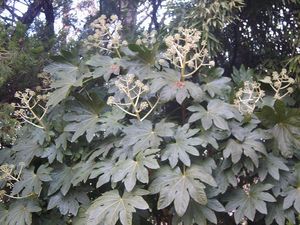Oddly enough, the Japanese aralia that I have is not being grown as a houseplant. Mine is growing in the ground in my yard. Once again, oddly enough, it should not be growing outdoors in my zone 6 region of Northeast Tennessee. [See my article Growing Plants Where They Shouldn’t Grow.] That being said, the Japanese aralia is more frequently grown as a houseplant.
The Japanese aralia (Fatsia japonica, sometimes also called Aralia japonica or Fatsia sieboldii) has large leathery, maple-like leaves. Indoors, the leaves are not as dark a green as they are when the plant is grown outdoors. The leaves of the indoor plants also have a softer texture, as well.
The Japanese aralia that is grown indoors as a houseplant also prefers cool temperatures, not over 65 degrees Fahrenheit. During the winter months, it likes a temperature around 45 degrees. Give it bright light, though, which helps to keep its growth a bit in check. (Japanese aralias can grow to be 5-feet-tall and just as wide.) The light also helps the plant to develop sturdy stalks.
Your Japanese aralia should be kept well watered during its growing period. During its period of rest, usually during the winter months, only moderate watering is necessary. The soil should still be kept moist. Japanese aralias that are allowed to become too dry will start losing their leaves. Do let the upper third of the potting soil dry out, though, between waterings. Also provide it with some humidity. [See: Houseplants: Increasing the Humidity.] You should also fertilize with a standard fertilizer every two weeks during the growing period.
Plant your Japanese aralia in a standard potting soil that contains extra fertilizer. (You can add some time-release granular fertilizer to your potting mixture.) You will also need to re-pot it every spring until it reaches its full height. (Japanese aralias require very large pots.) You might try to stunt its growth by keeping it in a smaller pot; however, I do not think you will be pleased with the results. Its growth can become rather distorted and not very pretty. (Bite the bullet and put it in a larger container.) You can control its growth, though, by pruning it hard. Cut it back by half in the spring. One other note: This plant will drop its older, lower leaves from time-to-time, so do not panic.
As mentioned earlier, the Japanese aralia can be grown outdoors. It is hardy to zone 8. As I also mentioned earlier, I have one growing outdoors … in zone 6. However, if you live further north than zone 8, you will probably prefer to grow this plant as a houseplant.
Reference:
Huxley, Anthony. Success with House Plants. Pleasantville, NY: The Reader’s Digest Association, Inc., 1979, pp. 201-2.
